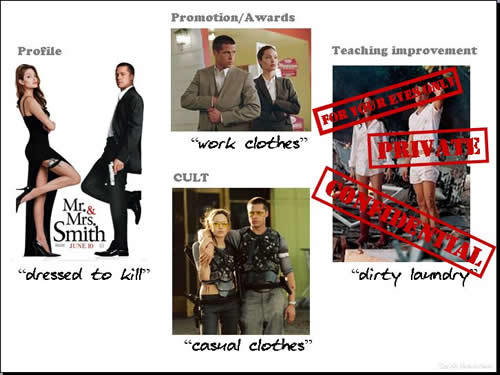Teaching Portfolio dress for the occasion
I was part of a panel presentation today on teaching portfolios. A teaching portfolio is basically a comprehensive record of your teaching career. It usually includes some commentary from you about how you feel about teaching and what you do as a teacher, as well as evidence of your teaching practice.
There are many different reasons why a teaching portfolio might be created, and the portfolio is going to be different for each application. In my part of the presentation, I tried to explain this using the simile of a teaching portfolio being like a wardrobe full of clothes.

Dressed to Kill. If you want to make a good impression but don't have much room, you bring out the equivalent of your sunday best. Often called a teaching profile, this style of portfolio is a brief summary of teaching activities, aimed to portray you in the best possible light. This is often used in a CV.
Work Clothes. If you have more space and time, but still want to look polished & professional, you use the equivalent of your work clothes. This portfolio will be longer, have more breadth and depth about teaching activities, and will still be fairly flattering. This sort of portfolio would be used when applying for academic promotion and continuation, and for applying for teaching awards.
Casual clothes: For a more critical and reflective look at your teaching, you want material that sometimes doesn't always show you at your best, like your casual slop-around-the-house-on-sunday clothes. This portfolio will include some of your weaknesses as a teacher, and will often explore how they can be remedied. This reflective portfolio is often a requirement of qualifications, such as CULT (Certificate of University Learning and Teaching) from the University of Auckland.
Dirty laundry: If you truly want to improve your teaching, you need to look at the stuff that you try to keep hidden. This is a real warts-and-all look at your weaknesses and an exploration of the things that have gone bad, or haven't worked in your teaching. Although it's often painful to keep track of this stuff, it is the most useful for improving teaching. However, it's the sort of thing that you probably wouldn't show to anyone except perhaps close friends and trusted mentors.
A teaching portfolio is a living document. To stretch the clothing analogy even further, you should keep adding to it throughout your career to keep it fresh. Then, when asked to prepare a teaching portfolio, you can go into your wardrobe and pull out all the clothes that are needed for the purpose.